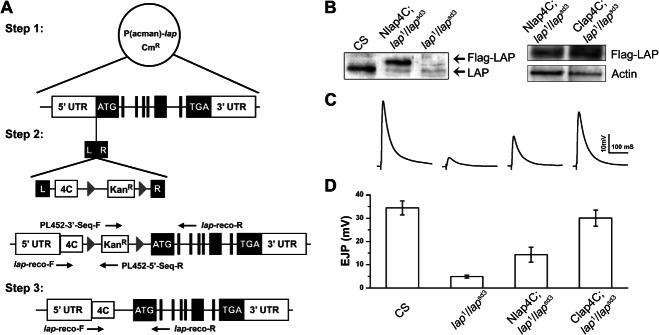Figure 1. Genetic rescue of lap mutant.

A) P(acman) vectors containing the full genomic sequence of LAP were modified by attaching a FALI-sensitive Flag-tetracysteine (4C) cassette to either the N- or C-terminus and incorporated into flies using PhiC-31-mediated transgenesis (see Materials and Methods for details). B) Left panel: Equal concentrations of total protein from adult fly head extracts as determined by BSA protein assay were loaded on SDS–PAGE gels and analyzed by Western blot using an antibody to the Drosophila LAP protein. Although endogenous LAP is present in control extracts (CS), its level is markedly reduced in both transgenic Nlap4C; lap1/lapsd3 and the mutant lap1/lapsd3 flies. Further, a band representing Flag-tagged LAP (with a slightly larger MW) is present only in the transgenic flies. Right panel: FLAG-tagged lap4C expression levels are examined using Western blot with actin as a loading control. Clap4C appears to be expressed at higher levels compared to Nlap4C, which may account for the better rescue of synaptic physiology shown below. C and D) The amplitude of EJPs in lap mutants is drastically reduced relative to control animals [down from 34.4 ± 3.0 mV (n = 8) in the control to 4.9 ± 0.7 mV (n = 7) in the lap mutant]. The Nlap4C; lap1/lapsd3 transgenic flies show partial rescue (14.3 ± 3.2 mV, n = 6) in the mutant background, whereas the Clap4C; lap1/lapsd3 transgenic flies exhibit almost complete rescue of physiology (30.0 ± 3.4 mV, n = 6).
